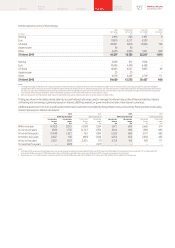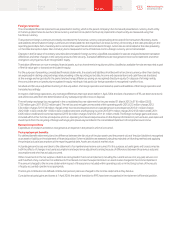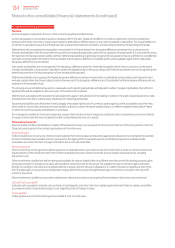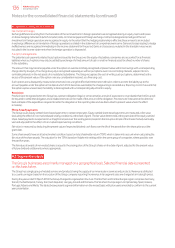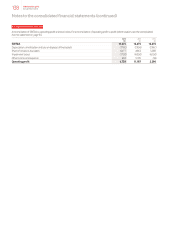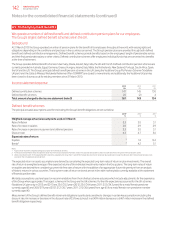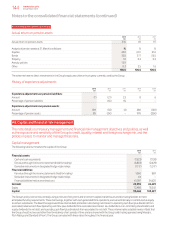Vodafone 2013 Annual Report Download - page 136
Download and view the complete annual report
Please find page 136 of the 2013 Vodafone annual report below. You can navigate through the pages in the report by either clicking on the pages listed below, or by using the keyword search tool below to find specific information within the annual report.
A1. Signicant accounting policies (continued)
Taxation
Income tax expense represents the sum of the current tax payable and deferred tax.
Current tax payable or recoverable is based on taxable prot for the year. Taxable prot differs from prot as reported in the income statement
because some items of income or expense are taxable or deductible in different years or may never be taxable or deductible. The Group’s liability for
current tax is calculated using UK and foreign tax rates and laws that have been enacted or substantively enacted by the reporting period date.
Deferred tax is the tax expected to be payable or recoverable in the future arising from temporary differences between the carrying amounts
of assets and liabilities in the nancial statements and the corresponding tax bases used in the computation of taxable prot. It is accounted for using
the statement of nancial position liability method. Deferred tax liabilities are generally recognised for all taxable temporary differences and deferred
tax assets are recognised to the extent that it is probable that temporary differences or taxable prots will be available against which deductible
temporary differences can be utilised.
Such assets and liabilities are not recognised if the temporary difference arises from the initial recognition (other than in a business combination)
of assets and liabilities in a transaction that affects neither the taxable prot nor the accounting prot. Deferred tax liabilities are not recognised to the
extent they arise from the initial recognition of non-tax deductible goodwill.
Deferred tax liabilities are recognised for taxable temporary differences arising on investments in subsidiaries and associates, and interests in joint
ventures, except where the Group is able to control the reversal of the temporary difference and it is probable that the temporary difference will not
reverse in the foreseeable future.
The carrying amount of deferred tax assets is reviewed at each reporting period date and adjusted to reect changes in probability that sufcient
taxable prots will be available to allow all or part of the asset to be recovered.
Deferred tax is calculated at the tax rates that are expected to apply in the period when the liability is settled or the asset realised, based on tax rates
that have been enacted or substantively enacted by the reporting period date.
Tax assets and liabilities are offset when there is a legally enforceable right to set off current tax assets against current tax liabilities and when they
either relate to income taxes levied by the same taxation authority on either the same taxable entity or on different taxable entities which intend
to settle the current tax assets and liabilities on a net basis.
Tax is charged or credited to the income statement, except when it relates to items charged or credited to other comprehensive income or directly
to equity, in which case the tax is recognised in other comprehensive income or in equity.
Financial instruments
Financial assets and nancial liabilities, in respect of nancial instruments, are recognised on the Group’s statement of nancial position when the
Group becomes a party to the contractual provisions of the instrument.
Trade receivables
Trade receivables do not carry any interest and are stated at their nominal value as reduced by appropriate allowances for estimated irrecoverable
amounts. Estimated irrecoverable amounts are based on the ageing of the receivable balances and historical experience. Individual trade
receivables are written off when management deems them not to be collectible.
Other investments
Other investments are recognised and derecognised on a trade date where a purchase or sale of an investment is under a contract whose terms
require delivery of the investment within the timeframe established by the market concerned, and are initially measured at cost, including
transaction costs.
Other investments classied as held for trading and available-for-sale are stated at fair value. Where securities are held for trading purposes, gains
and losses arising from changes in fair value are included in net prot or loss for the period. For available-for-sale investments, gains and losses
arising from changes in fair value are recognised directly in equity, until the security is disposed of or is determined to be impaired, at which time
thecumulative gain or loss previously recognised in equity, determined using the weighted average cost method, is included in the net prot
or lossfor theperiod.
Other investments classied as loans and receivables are stated at amortised cost using the effective interest method, less any impairment.
Cash and cash equivalents
Cash and cash equivalents comprise cash on hand and call deposits, and other short-term highly liquid investments that are readily convertible
to a known amount of cash and are subject to an insignicant risk of changes in value.
Trade payables
Trade payables are not interest bearing and are stated at their nominal value.
Notes to the consolidated nancial statements (continued)
134 Vodafone Group Plc
Annual Report 2013





